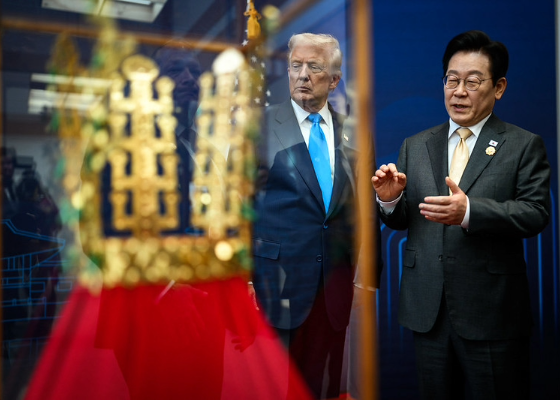South Korea finds all that glitters is not gold in managing US relations
As the shine of Donald Trump’s ‘golden welcome’ in South Korea wears off, Dongwook Kim writes President Lee Jae-Myung’s US diplomacy risks turning to scrap metal because of deep differences over economics and security.
19 November 2025

On the face of it, the 29 October summit between US President Donald Trump and South Korean President Lee Jae-Myung ahead of the Asia-Pacific Economic Cooperation (APEC) forum went well.
Lee succeeded in wooing the gold-obsessed Trump and securing better deals by awarding the US president the Grand Order of Mugunghwa made of 712.5 grams of gold and gifting him a golden Silla Kingdom crown replica glided with 1,000 grams of gold.
The unexpected Trump approval for South Korea to build a conventionally-armed, nuclear-powered submarine, on the condition construction take place at a Hanwha-owned shipyard in Philadelphia, crowned South Korea’s diplomatic success at the summit.
However, it took until 14 November for the US and South Korea to release a Joint Fact Sheet as the official record of the outcome. Furthermore, the fact sheet revealed compromises over some of the core bargaining outcomes South Korea initially asserted to have won.
The US-Korea summit and fact sheet signal new directions in their security and economic alliance. Militarily, while under US pressure to play a more active role in the US-led anti-China containment, South Korea now aspires to pursue a more self-reliant national defence policy that would not necessarily align with the needs of the US down the road.
US “approval for the ROK [Republic of Korea] to build nuclear-powered attack submarines,” as stated in the fact sheet, potentially represents a significant step up in capability and strengthens self-reliance. It was Lee who put the idea on the negotiating table first during the summit. South Korea does not want the so-called Australian model in which pre-made nuclear reactors are to be installed in AUKUS-class vessels. South Korea seeks to build its own nuclear submarine power plants, including the freedom to enrich or reprocess nuclear fuel.
It intends to build Korean-designed nuclear-powered submarines including Korean-designed, and made, submarine reactors in South Korea—not the US. South Korea thinks it already possesses the know-how, skills, and facilities. What it most wants from the US is approval to enrich uranium by up to 20% and to reprocess spent fuel from its civilian reactors by amending the so-called 123 Agreement. That agreement, which has the status of a bilateral treaty, restricts US-South Korea nuclear cooperation to peaceful civil uses of nuclear energy in compliance with the 1968 Treaty on the Non-Proliferation of Nuclear Weapons. Lee has told Trump that if the US approves fuel supply arrangements, South Korea would build the submarines “using our own technology.”
Lee’s pursuit of both nuclear-powered submarines and amendment of the 123 Agreement is driven by the desire for nuclear sovereignty and defence self-reliance in line with the Democratic Party’s commitment to national self-determination in foreign affairs that dates back to Lee’s predecessor Roh Moo-hyun (2003-2008). This differs in intent from Australia’s AUKUS submarine deal, which tethers Australia more closely to the US. Lee’s intention behind nuclear-powered submarines can be better understood when considering his campaign promise to pursue “the transfer of wartime operational control from the US back to South Korea under the US-Korea Alliance.”
However, while the fact sheet supports both South Korea’s nuclear-powered submarine-building and “the transition of wartime operational control,” it does not offer any prospect of amending the 123 Agreement. It only states that the “United States will work closely with the ROK to advance requirements for this shipbuilding project, including avenues to source fuel.” It also is silent on the location of submarine-building.
Economically, the Trump-Lee summit and fact sheet highlights the increasing tension between security and economic relations with the US. Among other things, the US will apply a 15% reciprocal tariff rate to South Korean goods, cap its sectoral tariffs on automobiles, auto parts, and pharmaceuticals at 15%, and impose tariffs on South Korean semiconductors on terms that are no less favourable than those for, say, their Taiwanese counterparts. Also, South Korea has pledged to invest a total of US $350 billion in the US, with US $200 billion coming from the South Korean government. The US-Korea trade and investment deals seek to coax South Korea away from its heavy economic reliance on China.
The US under Trump is no longer either a “benign hegemon” or a bountiful free market. Although South Korea has succeeded in lowering the US sectoral tariff rate on automobiles from 25% to 15%, it used to enjoy a zero tariff under the 2012 US-Korea Free Trade Agreement. Moreover, the investment deal will not only impose a huge fiscal burden on South Korea (for example, with the annual investment cap of US $20 billion amounting to 64.5% of its entire trade surplus with the US for the first half of 2025), but also increase the volatility of the US-Korea exchange rate by forcing South Korea to use its dollar reserves for investment.
Simultaneously, South Korea’s China economic strategy is increasingly unsustainable. As China pursues an innovation-based knowledge economy, it has begun to encroach on South Korea’s global markets in core export sectors such as semiconductors, high-tech electronics, petrochemicals, and ships. In addition, China is losing its traction as South Korea’s greatest export market. The Trump-Lee summit has done nothing to ease the strategic contradiction for a country caught in US-China rivalry.
Despite the progress made by Trump and Lee, they have not cemented the US-Korea security and economic alliance. This is because both the security and economic outcomes fall short of Seoul’s hopes. South Korea’s pursuit of self-reliant national defence via nuclear-powered submarines and the transfer of wartime operational control may be at odds with the active role that the US expects South Korea to play in its anti-China containment, while South Korea simultaneously struggles to manage the competing economic pressures from the US and China. It remains to be seen whether the Trump-Lee summit and subsequent fact sheet will turn out to be a real gem or glittering scrap metal for South Korea.
Dongwook Kim is Lecturer in International Relations and Convenor of the International Relations Program in the Australian National University’s School of Politics and International Relations.
Image: “P20251029DT-1095” by The White House, United States Government Work
How can we help? Get in touch to discuss how we can help you engage with Asia
